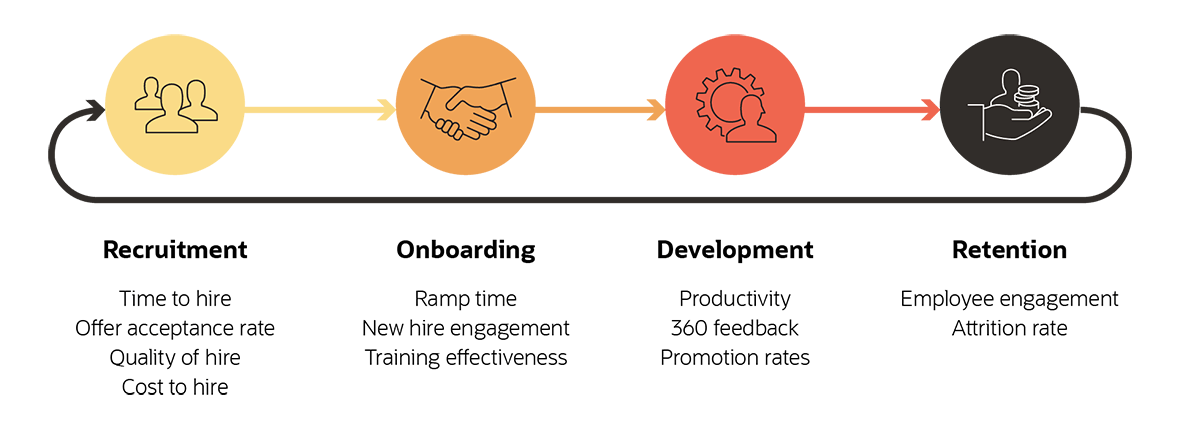Business owners and leaders know a strong team is the backbone of their company’s success. While they may talk about their team as extended family, in reality, nearly all businesses will see employees come and go over time. That makes evaluating and improving each step of the employee life cycle vital.
The employee life cycle extends from the moment a potential employee first learns about the company until the time they exit. While some models focus on five or six life cycle stages, we’re going to take a deeper look at 11 stages in the employee life cycle, with a keen focus on how to measure and optimize the employee experience along the way. Keep reading to learn more about the employee life cycle and why it matters to your business.
What Is the Employee Life Cycle?
The employee life cycle is a model that works to explain the various stages most employees will experience with their employer.
The life cycle begins when an employee learns about a company or job opportunity, continues on through their recruitment, hiring and onboarding into their time working for the company, and finally extends to their exit and post-employment experience.
Depending on your company’s size, the type of workers you employ and your industry, the steps in your employee life cycle will vary. However, the overall path from hiring to exit is often similar, regardless of the work being done.
Key Takeaways
- Measuring employee life cycle metrics can help you understand if your business is moving in the right direction.
- Examining the intricacies of each stage, like the candidate experience, onboarding and engagement, can lead to more productive, happier employees.
- Low turnover can save on hiring expenses while helping to retain top performers and their expertise.
Employee Life Cycle Explained
Monitoring the employee life cycle can help business owners and managers better understand and predict what employees will go through during their employment. A particularly positive or negative experience during any stage could affect the entire organization.
For example, once new employees sign on to start work, a smooth and low-stress onboarding process can help them get up to speed quickly so they can start contributing. However, if you don’t have an onboarding plan, those new workers may find themselves bored, frustrated and lost in their new role.
From there, an employee’s experiences can influence how long they stay with the company and may inspire others either to stay longer or start hunting for a new job elsewhere. The moment an employee leaves the company, the exit interview, can itself affect the employee experience.
Monitoring and improving upon the employee life cycle can be crucial to the long-term success of the company and its profitability.
Why Is the Employee Life Cycle Important?
Reviewing and planning around life cycle stages can help your business improve the overall employee experience, which benefits the business in many ways from more productive employees to improved customer loyalty.
Two of the employee life cycle stages that are most clearly tied to bottom-line success are recruitment and retention. The average U.S. employer spends about $4,000 and takes 24 days to hire a new worker. If you can keep employees around longer, you’ll have fewer positions to fill over time.
Better management of that recruitment process can help you save as well. Depending on how you measure and manage the process, the cost of recruitment can be much higher, with another study putting the average cost of a new hire at $6,110.
Once an employee finishes training—which can be quite expensive in its own right once you factor in their pay, plus the pay of any other staffers involved in training—they may develop business-specific expertise that makes them even more valuable. As an employee’s knowledge and skills grow, keeping them may be a challenge, but it should still be the goal and something you work toward.
However you measure it, bringing in new employees is expensive. Keeping employees happy and engaged can help extend the average time employees stay at your company. That’s why improving employee life cycle management could have a lasting impact on a company’s future.
What Are the Stages of the Employee Life Cycle?
While many companies follow a simple five- or six-stage life cycle, considering this expanded list of 11 stages that can help you better understand and optimize your employee experience.
- Attraction
- Recruiting
- Interviewing
- Onboarding
- Engagement
- Development
- Retention
- Recognition
- Offboarding
- Separation
- Alumni
11 Stages of the Employee Life Cycle Strategy
Developing a complete understanding of the employee life cycle stages can help your business improve its workforce management, in turn positioning the company for future success.
1. Attraction
The employee life cycle begins before you’ve even made any contact with the person in many cases. Employees start their journey with a company in the attraction phase. While attraction may be easier for well-known national brands, prominent local businesses or industry-leading organizations, you can’t hire anyone unless they’ve heard of your business—whether through a job posting or elsewhere—and have some interest in what you do.
2. Recruiting
Recruiting is where you interact with a prospective employee for the first time. During the recruitment stage, a prospective worker will become more familiar with your company culture and what the job entails. Consider the benefits of using current employees and your own network when seeking qualified candidates over outside firms.
3. Interviewing
Interviewing is a critical phase of the employee life cycle. During the interview, both the employer and the candidate should ask questions and get a feel for whether or not the position is a good fit. While most employers look at interviews primarily as a step in qualifying employees, it’s just as important for the interviewee to determine if the job and company culture is right for what they want in a job or career and the employer must be able to help communicate that in the interview.
4. Onboarding
Think back to your first day at work. It can be exciting, overwhelming and stressful all at once. Ensuring employees get off to a successful start is a team effort. Hiring managers, human resources (HR) and IT often need to collaborate to get an employee onboarded and trained as efficiently as possible while also instilling company values and connecting them with colleagues.
5. Engagement
Once the new job’s initial excitement wears off and workers settle into a routine, they may become complacent. Strong company culture and a focus on employee engagement can help keep your employees excited about what they do when starting work every day. Engaged employees are generally more productive and likely to stay in their position longer.
6. Development
While some workers are happy to stay in the same role for many years, others are motivated to improve their skills and move up within the organization. Even if you have a small business where there are few opportunities for promotions, you can give staffers new responsibilities and projects to help them grow within their roles. Regular pay raises go a long way as well.
7. Retention
Employee attrition is a natural part of running a business. But you can take steps to retain your best performers. That means listening to their suggestions, empowering them to improve how they do their work, keeping them engaged and ensuring they are comfortable in their daily routine.
8. Recognition
A steady paycheck and strong benefits are most likely the main reasons someone goes to work every day but going a step further with regular employee recognition can boost employee happiness and dedication to the team. Encouraging managers to recognize a job well done and offering workers a way to acknowledge their peers can be beneficial for everyone involved.
9. Offboarding
When an employee leaves, they hopefully do so on good terms. Instead of escorting someone out of the building when they give two weeks’ notice, it’s best to plan for a smooth transition of duties, cross-training for anyone who may need to temporarily take over a project or task and preparation of final payroll and benefits.
10. Separation
In an ideal situation, employees leave your company with fond memories and well wishes for their peers. To improve your future results, make sure you take the time to understand why the employee is leaving and get honest feedback on what you can do to make the company a better place to work in the future. Once you’ve taken care of things like network account access, keys and company assets, you may want to host a friendly goodbye lunch or happy hour to celebrate their time at the company.
11. Alumni
After an employee leaves and any final paperwork is done, they may not disappear from the company’s orbit forever. In addition to ongoing friendships with current employees, company alumni may still be a source of future referrals. You may even find you’ll work with them again at some point in the future. Doing your best to not burn bridges is the best strategy for everyone involved.
12 Employee Life Cycle Metrics

Here are some metrics that can help business track and improve the various employee life cycle stages:
Recruitment
- Time to hire: The number of days from the time a job is posted until a candidate is hired. The lower this number, the better.
- Offer acceptance rate: A higher offer acceptance rate means you are doing a good job vetting, interviewing and finding the right fit for openings, and that your pay and benefits are competitive.
- Quality of hire: This is a score that explains how well a new hire fits the job requirements. Measuring this may require collaborating with the manager.
- Cost to hire: It’s reasonable to spend a significant amount on hiring but overspending on recruitment cuts into your bottom line.
Onboarding
- Ramp time: When your new employees start, how long does it take them to get up to speed? A shorter ramp time indicates that your training is efficient and effective.
- New hire engagement: Getting new hires engaged with the company and its culture is critical. A 90-day survey or other feedback can help you assess the success of new hire engagement.
- Training effectiveness: Training an employee quickly isn’t worth much if they don’t know how to do their job well. In addition to ramp time, it’s also wise to measure training effectiveness through a survey or conversations with their manager.
Development
- Productivity: Productivity is one of the most important HR metrics in any business. Employee output is a core metric to use to determine it.
- Regular feedback: Managers and employees should provide feedback on a regular schedule. Many companies employ quarterly check-ins and an annual review, though some managers also like to have weekly one-on-one meetings to discuss priorities, address challenges and further develop the employee.
- Promotion rates: A high promotion rate indicates you are doing a good job hiring for both the position and the company and that workers succeed in their roles. It’s also a sign you are rewarding top performers, which encourages them to stay.
Retention
- Employee engagement: Employee engagement is a strong indicator of an individual’s likelihood of staying at the company. This is one of the most common and critical human resources metrics. It is often measured through employee surveys, among other inputs.
- Attrition rate: A high rate of workers leaving the company is an expensive problem and will hurt your organization long term. Low attrition is a signal that employees are happy, fairly compensated and engaged.
Employee Life Cycle Trends
When considering the stages of the employee life cycle at your company, it’s easy to get caught up in the metrics. But don’t just look at those metrics in isolation. It’s also a good idea to look outside of your organization for new employee life cycle trends.
To keep employees around longer and minimize attrition, modern employers are looking to innovative HR policies such as unlimited paid vacation, flexible work hours, student loan repayment assistance, wellness programs and education assistance. What works best for your workforce may be unique, so get to know your employees to custom tailor any industry trend to your business.
Once you adopt a new HR policy aimed at improving your employee life cycle, follow related reports in your company’s enterprise resource planning (ERP) and HR systems to measure their effectiveness.
Simplify
HR and Payroll
Managing the Employee Life Cycle With HR Technology
Technology is taking on a bigger role in nearly every profession, and that includes human resources. With leading HR systems in place, you can easily view dashboards that give you a holistic perspective on employee life cycle metrics. Company dashboards and team scorecards can give you insights on your employee life cycle in just a few clicks.
A human resources management system (HRMS) can provide many of these insights in one place. Using key performance indicators (KPIs) and dashboards, HR leaders can spot any signs of trouble and then come up with ways to address them quickly, and managers can publicly recognize members of their team for exceptional work. The best HR systems store detailed employee records, performance reviews including any role changes and raises, and allow managers to create employee onboarding and offboarding checklists. They also let employees view time-off balances, compensation, benefits and enable them to update any personal information as necessary. Each of these features can contribute to a better employee experience.
By taking the time to evaluate your employee life cycle, understand your current metrics and continuously improve, you are creating a workplace that’s more enjoyable, engaging and productive. A positive employee experience often translates to a bigger bottom line, so if you’re not already doing so, you should start building a plan to assess and improve your employee life cycle today.









